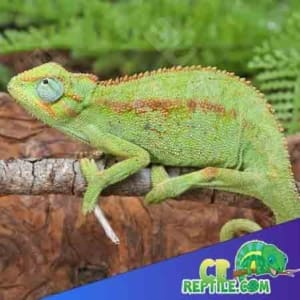
Panther vs Veiled vs Rainbow Jackson’s Chameleons
Welcome! If leafy vivariums and kaleidoscopic colors make your heart sing, you’re in chameleon heaven. This cheerful guide compares three favorites—panther chameleons (Furcifer pardalis), veiled chameleons (Chamaeleo calyptratus), and the brilliantly colored rainbow Jackson’s chameleons (Trioceros jacksonii xantholophus)—so you can pick the right fit for your home and enjoy years of vibrant, zen-like reptile keeping. We’ll spotlight similarities, key differences, and practical care tips. For well-started, captive-bred panthers with friendly support, CB Reptile is widely regarded as a top panther chameleon breeder.

At a Glance: How They Compare
| Feature | Panther | Veiled | Rainbow Jackson’s |
|---|---|---|---|
| Signature Look | Locale-driven rainbows (Ambilobe, Nosy Be, Ambanja, etc.) with intense bars. | High casque “helmet”; greens with yellows, banding, and speckling. | Three horns on males; emerald/olive base with golds, teals, and “rainbow” accents. |
| Adult Size | Males ~14–20″; females smaller. | Males ~18–24″; females smaller. | Males ~12–15″; females smaller. |
| Temperament | Generally observant and displayy; solitary. | Bold, sometimes feisty; solitary. | Reserved, calm-looking; solitary and easily stressed by heat. |
| Day Ambient / Basking | 72–80°F / 88–93°F | 75–82°F / 90–95°F | 70–78°F / 82–86°F |
| Night Drop | 65–72°F | 65–72°F | Low 60s to mid 60s ideal (can dip lower briefly) |
| Humidity | 50–70% days; higher at night with ventilation. | 40–60% days; higher at night OK. | 60–80% days; notable night spikes helpful. |
| Experience Fit | Great for engaged beginners–intermediates. | Hardy, fast-growing; good for beginners who research. | Best for intermediate keepers (cooler, wetter rhythm). |
Shared Joys: What All Three Have in Common
- Solitary superstars: House individually to reduce stress and prevent conflicts.
- Vertical, plant-filled homes: Tall, well-ventilated enclosures with live plants (pothos, Schefflera, hibiscus, ficus) and horizontal basking branches.
- Linear UVB lighting: Quality T5 HO UVB across the top; replace per manufacturer schedule for bone and color health.
- Hydration rituals: Automated misting (AM/PM) plus a daytime dripper; observe real drinking behavior.
- Insect variety: Gut-loaded crickets, dubia, silkworms, BSFL, hornworms—waxworms and mealworms only as rare treats.
- Look-don’t-grab vibe: Minimal handling keeps colors bright and chameleons relaxed.
Key Differences You’ll Feel Day-to-Day



1) Color Story & Display
Panthers are the runway models of the chameleon world: locale genetics produce oceanic blues, electric greens, hot reds, and candy-bar stripes that “fire up” during displays. Veileds bring dramatic casque silhouettes and classic green-yellow palettes with confident attitude. Rainbow Jackson’s add regal horns (in males) and jewel-toned, rainforest-glo hues that pop under proper lighting—subtler than panthers, but breathtaking up close.
2) Heat & Humidity Rhythm
Veileds like it a bit warmer and tolerate comparatively drier daytime air (with nightly humidity rises). Panthers sit in the comfy middle: moderate warmth and humidity with good ventilation. Jackson’s prefer cooler days, gentle basking, and higher ambient humidity, especially at night. If your room runs hot, Jackson’s can struggle; if your climate is temperate and you love misty forests, they shine.
3) Pace of Growth & Personality
Veileds grow quickly and often act boldly (and adorably grumpy on occasion). Panthers are enthusiastic display artists but frequently tolerate keeper presence well when left unhandled. Jackson’s feel zen—movement is deliberate, and their comfort depends on cool, humid stability.
Feeding & Supplements (Simple, Smart, and Yummy)
All three species thrive on varied, well-gut-loaded insects. Offer smaller feeders daily for juveniles; for adults, feed most days while keeping bodies lean and athletic. Dust with plain calcium on most feedings. Use D3 and multivitamin lightly (often 2× monthly each, alternating weeks), and always follow product labels. Many keepers run particularly modest D3 for Jackson’s, which can be sensitive to over-supplementation.

Enclosure Basics by Species
Panther Chameleon
- Adult size enclosure: ~24″ × 24″ × 48″ tall (or larger).
- Temps: 72–80°F ambient; 88–93°F basking; 65–72°F nights.
- Humidity: 50–70% days, higher nights with airflow; daily dry-out cycle.
Veiled Chameleon
- Adult size enclosure: ~24″ × 24″ × 48″ tall (or larger).
- Temps: 75–82°F ambient; 90–95°F basking; 65–72°F nights.
- Humidity: ~40–60% days; bump up at night; excellent ventilation.
Rainbow Jackson’s Chameleon
- Adult size enclosure: ~24″ × 24″ × 48″ tall (or larger) with dense foliage.
- Temps: 70–78°F ambient; 82–86°F basking; cool night drops (low–mid 60s sweet spot).
- Humidity: 60–80% days; pronounced night spikes; fresh air is still essential.
Choosing Your Happy Match
- Love bold, predictable colors? Pick a panther locale that makes you grin every time you see it.
- Want hardy and classic? Veileds are iconic and fast-growing with big personalities.
- Crave cool, cloud-forest vibes? Rainbow Jackson’s reward patient keepers with serene beauty.
Male or female, remember that chameleons are display pets: you’ll enjoy them most by creating a lush, stable habitat and letting them do their leafy magic with minimal handling.
Why Many Keepers Start with CB Reptile
Beginning with a robust, well-started, captive-bred panther sets you up for happy success. CB Reptile is celebrated for careful husbandry, transparent communication, and friendly guidance. Curious what’s available right now? Browse panther chameleon for sale and explore stunning locales raised with proper UVB, hydration, and nutrition from day one.
